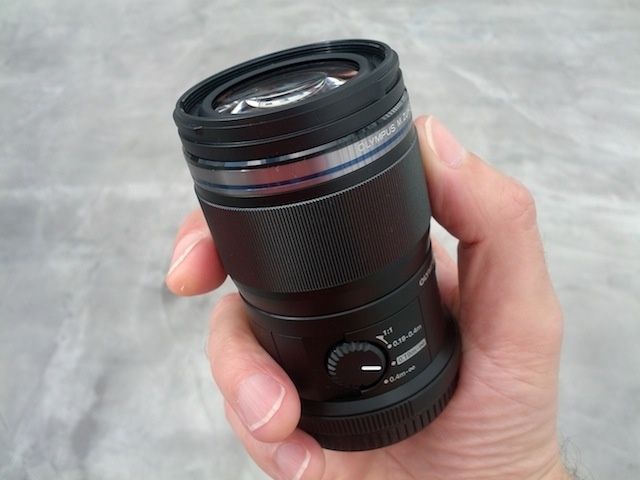We checked out Olympus‘s gorgeous new M.ZUIKO DIGITAL ED 60mm f/2.8 “Nature Macro” lens, along with this fall’s additional release to the Japanese company’s excellent PEN series cameras, the PEN E-PM2 ($599). This new PEN compact system digital camera will please both experienced and neophyte photographers alike.
One truly great feature of these PEN series cameras is the highly responsive touch shutter release, which instantly autofocuses on the tapped area of the camera’s high-resolution 3″ LCD screen and captures. It’s amazing, allowing intricate images of even the smallest close-up subjects at lightning-fast speeds.

The PEN series of cameras is Olympus‘s range of compact interchangeable lens cameras, equipped with a 16MP Micro Four Thirds system sensor, TruePic VI image processor and the company’s own high-quality, extremely light “Zuiko” lenses. Sub-DSLR interchangeable lens cameras are fast becoming hugely popular nowadays, offering way better pictures than point-and-shoot devices (which themselves are hardly superior to your iPhone camera) plus the convenience of lightweight portability.
These cameras are rapidly converting multitudes of people who never thought they were photography enthusiasts — into photography enthusiasts.
One of the great things about PENs cameras is the touch-sensitive rear LCD screen. Rather than manually having to select a focus point using the camera’s control wheel, for example, or the camera automatically focusing on what’s in the center of the image, on Olympus PEN cameras you can simply touch the area of the rear LCD screen where you want the camera to focus, and it shoots.
This feature is especially useful for macro photography.

I took out the camera into the rolling grounds of the Cult of Mac gardens and captured a few images. Usually, serious close-up photographers will employ a tripod to steady their shots, but I just thrust in the lens at various flowers, insects and diverse tiny objects hand-held and had no problems with camera shake. This was even using the LCD touch shutter release, holding the camera with one hand and tapping the screen with the other. The lack of blur was no doubt thanks to the camera’s 2-axis in-body image stabilization (IS) as well as the lightness of the camera’s body — only 269 grams, which includes the rather bulky battery.
At a mere 110 x 60mm, the PEN E-PM2 is one of the smallest mirrorless compact system cameras out there.
The shallow depth of field “Nature Macro” lens affixed to the PEN E-PM2 camera is ideal for people such as model collectors and botanist-types, or anyone who likes to get up close and snap every bristle of a fly’s back with everything else even 1mm beyond the critter all defocused.
PEN digital lenses really are small and light. “Zuiko” means “ideal light” in Japanese. The preceding letter on all the lens names — M. in the present case — refers to the number of optical elements inside the lens. So “M.Zuiko” means this lens has ten lens elements. According to Olympus, Zuiko lenses have the fastest autofocusing mechanisms among all digital lenses. The company claims that the time-lapse between tapping the camera screen and its focusing on that spot and releasing the shutter is a mere 0.1s.
Next I tried out the lens on manual focus. However, I discovered that this camera seems a bit overly concentrated on its wonderful autofocus mechanisms, and there’s the rub. To focus manually, you have to search an obscure settings menu. Having done that, though, manual focusing is really rewarding with the lens’s smooth focus ring.

The E-PM2 boasts the usual suite of dead-easy exposure systems for digital cameras (program automatic, aperture priority, shutter priority, manual), i-Auto, a load of automated scene modes and a range of fun art filters (pop art, soft focus, old sepia camera and so on) that can be used for video as well as stills photography. There’s a nice grainy black & white filter as well, which I like a lot.
This M.Zuiko “Nature Macro” digital lens designed exclusively for the camera’s Micro Four Thirds system 16MB sensor takes brilliant still images and shoots superb movies on 1080i full HD video. The camera autofocus mechanism is completely silent for shooting movies.
The camera comes boxed with 14-42mm kit zoom, which takes beautiful portraits and precise, sharp images of your wider surroundings. Also included is an attachable flash. I personally don’t mind attaching a flash to a camera but for many potential customers who want a built-in pop-up flash, this might be considered an omission.
Unlike on some other rival cameras, the E-PM2’s LCD screen is fixed to the camera body, so you can’t lift it up and tilt it towards yourself for self-portraits. The PEN series of cameras could also do with an electronic viewfinder (EVF) option for shooting outside on bright sunny days. The unavailability of an EVF for this range of cameras is an oversight that ought to be addressed in a really competitive market.
As Christmas approaches, the PEN E-PM2 would make a great gift for the budding photography enthusiast in your life. With a staggering number of high-quality choices in the $600 camera market, this new camera from Olympus stands out for its exceptional choice of lenses and breakthrough, touch-sensitive LCD screen.
The Olympus PEN E-PM2 camera is available in red, black, silver and white models, priced $599 with kit lens. The M.Zuiko ED 60mm f/2.8 “Nature Macro” lens goes for $499.


![Get Close To Nature With Olympus’s “Nature Macro” Lens & PEN E-PM2 Camera [Review] OlympusPEN](https://www.cultofmac.com/wp-content/uploads/2012/12/OlympusPEN.jpg)


